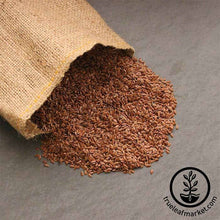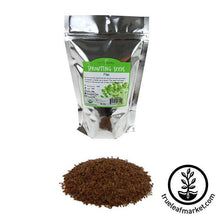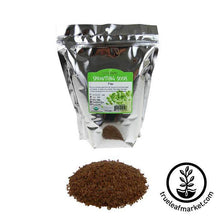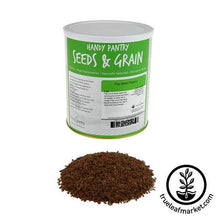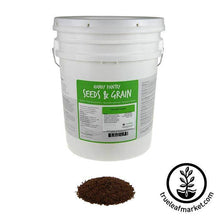
Brown flax seeds, Canadian variety. Great for grinding into flax meal for a great source of fresh, healthy flaxseed oil which is rich in Omega oils and other nutrients. Available in small amount to bulk in resealable packaging. Certified Organic.
Organic Brown Flax Seed - Canadian Brown Flaxseed
- Certified Organic
- Microbial Tested
- Resealable Packaging
- Will sprout, but not recommend for sprouting
- High in Omega Oils
- Great for Grinding into Flax Meal for smoothies, in cereal & more.
-
Seeds Per Package:
- 1 lb - Approximately 8,000 Seeds
- 2.5 lb - Approximately 20,000 Seeds
- 5 lb - Approximately 40,000 Seeds
- 30 lb - Approximately 240,000 Seeds
Flax seed has many important nutrients besides the fat--among which are protein, carbohydrates which include phenolic acids, lignins, and hemicellulose. Flax seed contains vitamin C, Vitamins B1, B2, Niacin, B6, Pantothenic Acid, Folic Acid and Biotin.
Do you want an easy way to get your Omega-3 essential oils? Ground flaxseed is one of the best ways to add healthy oil to your diet! Ground flax seed not only provides you with flax seed oil but provides you with nutritious fiber and it is easier for your body to use and digest. Ground flaxseed can be sprinkled on salads, mixed with a smoothie, or even eaten as a cereal. Looking for Golden Flax?
Frequently Asked Questions About Whole Flax Seed and Ground Flax Seed
1. Ground Flax Seed vs. Flax Seed Oil
We are among the proponents for ground flax seed versus flax oil because it is closer to nature. If it were possible to sprout it, we would advocate that but it is an impossible seed to sprout because it is so mucilaginous. Johanna Budwig in her book, Flax Oil As A True Aid Against Arthritis, Heart Infarction, Cancer and Other Diseases, discusses flax oil rather than ground flax seed. At the time she wrote her book, there was so such thing as a person having his own personal flax grinder. If one was to use ground flax, one would have to go to the health food store to have it ground and it would likely be rancid before it got home. Flax seed has many important nutrients besides the fat--among which are protein, carbohydrates which include phenolic acids, lignins, and hemicellulose. Flax seed contains vitamin C, Vitamins B1, B2, Niacin, B6, Pantothenic Acid, Folic Acid and Biotin. Flaxseed also has a great many minerals among which are calcium, copper, iron, magnesium, manganese, phosphorus, potassium, sodium, and zinc and many of the trace minerals. In addition, an important ingredient not found in the flax oil is enzymes which are needed to assimilate these minerals and vitamins.
2. Brown Flax Seed vs. Golden Flax Seed
The following information was taken from the Flax Council in Canada:
"A book recently published by Bantam Books, titled The Wisdom of Menopause, identifies the omega-3 fatty acids found abundantly in flax seed as being helpful in alleviating menopausal symptoms. However, the author mistakenly describes golden flax seed as being more nutritious than brown flax seed. In fact, brown flax seed is nutritionally equal or superior.
Both brown and golden flax seeds have plenty of protein dietary fibre, and alpha-linolenic fatty acid (ALA). While some people prefer yellow-coloured seed in their cooking, brown flax seeds add the same nutrition to the diet as do golden ones.
The author may have been mislead by a U.S. promoter of golden flax. This type of statement has been made in the past by such promoters, possibly as a way of justifying to consumers the high price of their products.
Generally, the cooler summers of the Canadian prairies give flax see an agronomic edge over the flax grown in other climates. Thus, a comparison of agronomic data on flax quality, compiled by the Canadian Grain Commission, shows that, as production moves south, the flax crop tends to produce seeds with less oil, higher protein content and lower ALA content. As golden flax is typically grown further south (in North and South Dakota), these characteristics can apply."
3. Rancidity of Flaxseed
According to Johanna Budwig and other flax seed experts, the oils in flax seed get rancid quite fast, within ten to fifteen minutes. Once the hull of a grain seed is broken, an acceleration of the oxidation process begins. One has to ask himself the question, How did they press the flaxseed oil? How long did it take them after it was pressed to get it refrigerated? Is the flax seed oil in an opaque bottle? Does it continue to get rancid slowly even if refrigerated? It is said that if the oil smells or tastes fishy, it is rancid.
4. What are the lower bowel benefits of Organic Flax Seed?
Ground flax seed is very mucilaginous. Therefore it absorbs massive quantities of liquid. This bulk, once consumed is very beneficial to the lower bowel or intestine. It makes a person's bowel movements regular, and keeps toxins from accumulating in a sluggish bowel. It is very important to add the ground flax to a liquid (i.e. juice or a smoothie) rather than a solid and/or drink several glasses of water after consumption.
5. Flax Seed Analysis for 100 grams!
- Thiamin......................... 7.6 MG
- Riboflavin....................... 0.2 MG
- Niacin.......................... 3.5 MG
- Pantothenic Acid............ 1.34 MG
- Calcium....................... 255.0 MG
- Phosphate................... 590.0 MG
- Sodium......................... 30.0 MG
- Potassium.................... 800.0 MG
- Iron.............................. 5.3 MG
- Manganese...................... 2.1 MG
- Linolenic Acid (Omega 3).... 2.7 G
- Carbohydrates........................16%
- Protein..................................22%
- Fat (high in Omega 3 Oil)..........65%




